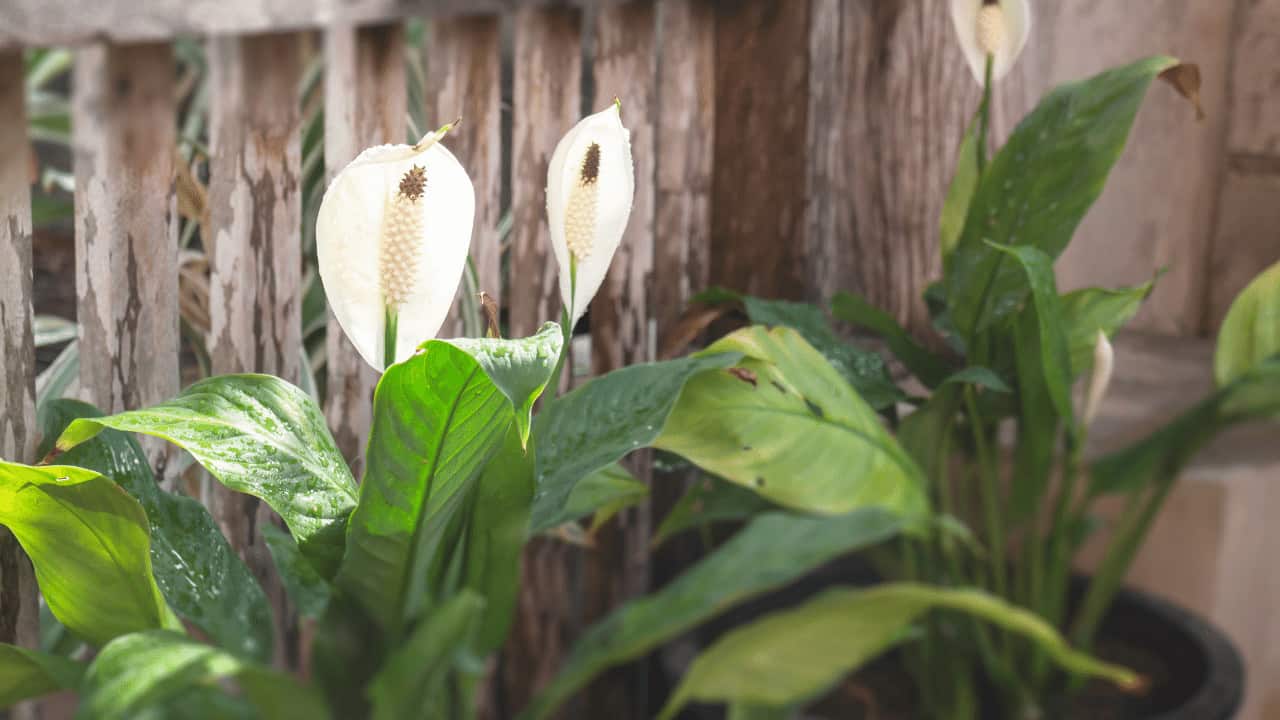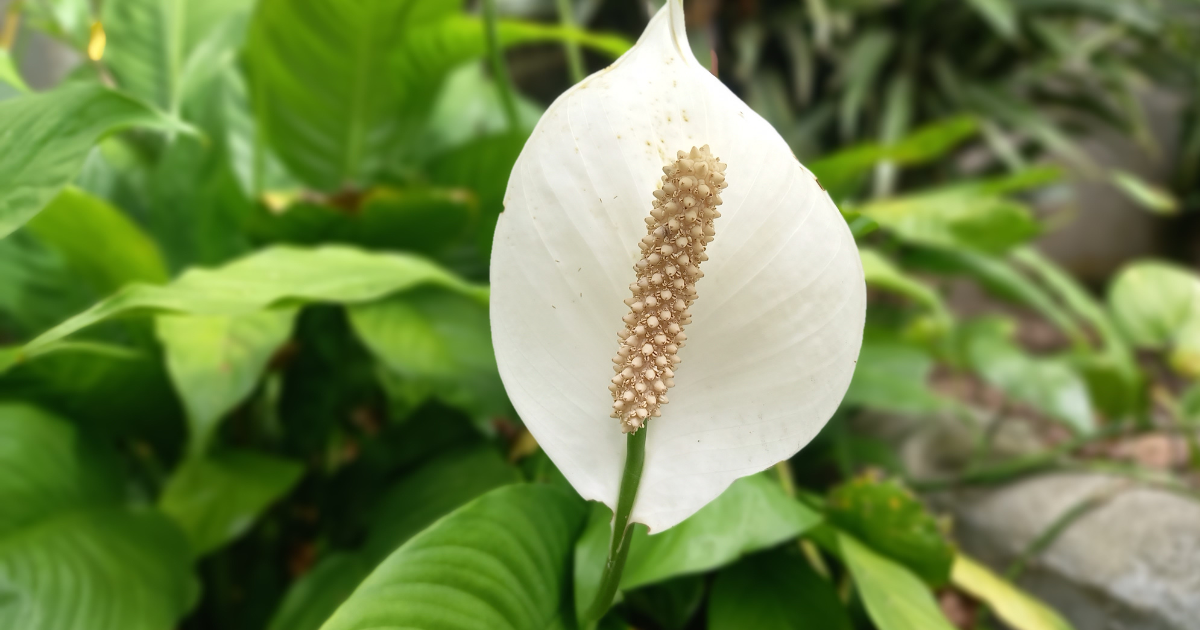People who like to keep plants inside often choose peace lilies, which have beautiful white flowers and lush green leaves. People often ask, “Can peace lily be outside?” The answer isn’t as simple as “yes” or “no,” because it depends on things like the weather, the plant’s environment, and how it’s cared for. We’ll talk about the options and give you important advice in this blog post for people who want to move their peace lily outside.
With their distinctive white blooms and lush greenery peace lily plants are a popular indoor choice. Their versatility and easy care make peace lilies a fixture in many homes. But some gardeners wonder if these tropical beauties can live outdoors. With careful acclimation peace lilies can thrive outside in the right conditions. Here’s how to transition an indoor peace lily to outdoor living.
Understanding Peace Lilies’ Tropical Origins
To determine if peace lily can adapt outside, consider where this plant naturally grows. Peace lilies hail from the humid, shady forest floors of Central and South America. Accustomed to filtered sunlight and steady warmth and moisture, peace lily thrives in habitats that mimic these rainforest origins.
Peace lilies expect:
-
Warm temperatures between 65-80°F,
-
Consistent humidity
-
Shelter from direct sun.
-
Moist, rich soil.
Any outdoor environment replicating peace lilies’ native conditions can potentially support their growth. But locations with cold winters or intense sun require adjustments.
Gradual Acclimation is Key
Sudden changes shock peace lilies. A plant moved straight from a dim indoor space to the heat and sun of a summer patio will likely struggle. Acclimate peace lilies slowly when transitioning outside.
Start with a Shaded Spot
A covered porch or spot under a tree works well. Dappled sunlight filtered through leaves imitates the rainforest canopy. The shelter protects plants from weather fluctuations. Mist foliage regularly to provide humidity.
Slowly Increase Sun Exposure
Over a few weeks, gradually move plants into areas receiving more sunlight. This gives foliage time to adapt and prevents leaf scorch. Monitor for signs of stress like wilting.
Be Ready to Adjust
Pay close attention and tweak conditions if plants show distress. Finding the right balance of sunlight, humidity and temperature may require adjustments to the microclimate or routine. Patience prevents shock.
Outdoor Care Tips for Peace Lilies
Peace lilies outside have slightly different care needs than houseplants.
Water 1-2 Times Per Week
Outdoor conditions cause quicker moisture loss. Test soil with a finger to gauge water needs and supplement rainfall. Allow soil to partially dry between waterings.
Apply Balanced Fertilizer
Feed with a balanced liquid or granular fertilizer every 2-3 months during the growing season. Outdoor peace lilies need more nutrients than houseplants.
Monitor for Pests
Aphids, scale and mealybugs may appear. Check undersides of leaves and treat promptly with horticultural oil or insecticidal soap.
Prevent Fungal Disease
Space plants for airflow and avoid wetting foliage to reduce risk of powdery mildew and other fungal diseases prevalent outside.
Shelter from Frost
In zones prone to winter freezing, move pots inside or cover plants when overnight temps drop below 45°F. Prolonged frost kills peace lily foliage.
Ideal Outdoor Conditions for Peace Lilies
While adaptable, peace lilies thrive best outdoors when:
-
Daytime temperatures remain above 65°F.
-
Nights stay above 50°F.
-
Humidity levels are moderate to high.
-
Soil stays consistently moist but not saturated.
-
Air circulation around plants is good.
-
They are shielded from hot, direct afternoon sun.
Mimicking the tropics enables peace lilies to prosper outside.
Growing Peace Lilies in Pots vs. the Ground
Container gardening offers flexibility if you’re unsure about peace lilies handling your climate:
Pots:
-
Let you easily move plants to moderated microclimates.
-
Require close monitoring of soil moisture. Dry out faster.
-
Can be brought indoors if conditions become intolerable.
-
May need daily watering during hot, dry weather.
Ground:
-
Insulates roots and retains moisture better than containers.
-
Makes moving plants harder if climate becomes unsuitable.
-
Demands excellent drainage; soggy soil causes root rot.
-
Is a more permanent option best for Zone 10 or warmer.
Evaluate your climate and growing goals when choosing pots or garden planting.
Common Problems with Outdoor Peace Lilies
Watch for these signs something is amiss with outdoor peace lilies:
-
Wilting or drooping leaves – Insufficient watering is most common but can also indicate root rot from overwatering.
-
Brown leaf tips or margins – Caused by excessive sunlight or salt buildup from fertilizer or water.
-
Yellowing leaves – Indicates too much direct sun or overwatering.
-
Leaf drop – Can result from abrupt temperature changes, overwatering, pests or disease.
-
Failure to flower – Insufficient light, malnutrition, or daytime temperatures consistently above 85°F can inhibit blooming.
Adjust care practices if plants show distress. But some leaf damage may be unavoidable in outdoor settings.
Enjoy Peace Lily Outdoors
The key to growing peace lily outside is gradually transitioning plants while trying to replicate the warm, humid, shaded conditions of their native habitat. Start by placing pots in a sheltered, shady spot and slowly adjust to increased sunlight exposure over time. With attentive care tailored to your climate, the popular peace lily houseplant can become a unique addition to the outdoor landscape.
Understanding Peace Lily’s Natural Habitat
To fully grasp the needs of a peace lily outside, we should delve deeper into its origins. The peace lily is from the thick, wet undergrowth of tropical rainforests in Central and South America. It is used to living under the trees. This environment provides a unique combination of high humidity, stable temperatures, and indirect sunlight. The nutrient-rich soil is on the forest floor, which is full of dead organic matter. The canopy above blocks the harsh sunlight.
This backdrop is crucial in understanding the peace lilys preferences. It tells us that peace lilies can live indoors, but they are naturally sensitive to the small changes in light and temperature that come with being outside under a canopy.
Assessing Your Local Climate
- When it comes to temperature, peace lilies have a small range of temperatures that they can handle. Even though 65°F to 80°F is the ideal range, it’s important to remember that sudden changes in temperature can be stressful. Peace lilies should be kept inside or given some other way to control the temperature in places where it gets below 60°F at night or during the winter.
- Needs High Humidity: Peace lilies are used to living in rainforests where the humidity is always high. This humidity is very important for their health; it affects everything from the texture of the leaves to the quality of the flowers. In drier climates, creating a micro-humid environment can be beneficial. Putting plants in a humidity tray or grouping them together can help make these conditions more like they are in nature.
- Light: They live in a place with dappled sunlight, which is very different from the harsh sunlight they’ll find outside. If you live in an area that gets a lot of sun, you need to make sure there is shade in the afternoon. A spot that gets soft morning sunlight and afternoon shade would work best.
Can Peace Lilies Be Planted Outside?
FAQ
Can peace lilies be put outside in the summer?
Where is the best place to put a peace lily?
How cold is too cold for a peace lily outside?
Is a peace lily better inside or outside?
Can peace lilies grow outdoors?
Peace lilies grow outdoors in clumps. If you are fortunate enough to live in zones 10 or 11, you can grow your peace lilies outdoors. Their bright white spathes will light up the shady areas of your yard year-round. They like light shade, tolerating only a little morning or late afternoon sun. Dappled shade is the best.
Where to plant peace lilies outside?
The best location of peace lily outside is a shaded spot with early morning sunlight or dappled sunlight. It is sensitive to direct sunlight, and it will scorch the leaves of your peace lilies. So, find a spot for the peace lily in your garden to protect it from strong winds where the water doesn’t pool after the rain.
Will peace lilies survive?
Well, the big question is whether or not it will survive. Generally, Peace Lilies can grow outdoors year-round in USDA plant hardiness zones 10 to 12. However, they need adequate moisture, shade from direct sunlight, and protection from pest infestation.
Should you bring peace lilies indoors?
A good rule of thumb is to bring peace lilies indoors before the first frost. This often occurs in the fall. Sudden drops in temperature can damage or kill your peace lilies, especially if they have become acclimated to the warmer outdoor conditions.
- The Ultimate Guide to Growing Strawberries in Raised Beds - August 8, 2025
- No-Dig Garden Beds: The Easiest Way to Grow a Beautiful Garden - August 6, 2025
- How to Protect and Preserve Wood for Raised Garden Beds - August 6, 2025


